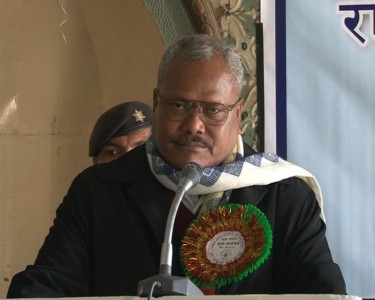Gachchhadar’s claim that Tharus form Nepal’s largest indigenous community is not true
Sujit Mainali / August 25, 2015
Addressing the Legislature-Parliament on August 12, 2015, Madhesi People’s Rights Forum-Democratic Chairman Bijaya Kumar Gachchhadar claimed that Tharu is the largest indigenous community of Nepal.
Click here to listen to his speech:
Hinting at the resentment expressed by the people in various parts of the country to the new federal map proposed by big parties, Gachchhadar said:
“People in the midwestern and farwastern regions are opposing it, indigenous nationalities are against it. Tharus form the largest indigenous community of Nepal (in terms of size of population), 1.6 million Tharus live in this country, from Mechi to Mahakali [zones].”
Is Tharu the largest indigenous community of Nepal, as claimed by Gachhchhadar?
No. According to the Census Report-2011 prepared by the Central Bureau of Statistics, Magar is the largest indigenous community of Nepal in terms of the size of population followed by Tharu.
Click here to read the census report:
Gachchhadar is nearly correct when he said that Tharu population stands at around 1.7 million (1,737,470). This is 6.6 percent of the total population of Nepal.
But Magar population stands at 1,887,733, which is 7.1 percent of the total population.
So, the claim by Gachchhadhar is incorrect.
Similarly, Gachhchhadar in an interview with the online edition of Nagarik Daily on 24 August further said:
“450,000 Tharus reside in Kailali and Kanchanpur alone. The total population of Tharus [in Nepal] is around 1.8 million and 450,000 live in Kailali and Kanchanpur.”
Click here to see the interview:
According to the national census of Nepal (2011), the total population of Kailali district is 775,709, of which 322,112 are Tharu. Similarly, the total population of Kanchanpur district is 451,248 and Tharu population in the district stands at 115,874.
Click here for Tharu population in Kailali and Kanchanpur districts:
The Tharu population in the two districts combined is 437,986, which is close to the claim by Gachchhadar that there are 450,000 Tharus in the two districts.
Similarly, after the meeting of the four major parties in Kathmandu on August 23, Gachchhadar had said this to the media:
“The total population of Nepal is 26.4 million and 13.5 million people live in Tarai-Madhesh.”
Click here to listen to Gachchhadar’s statement:
According to the 2011 census, the total population of Nepal is 26,494,504 and 50.26 percent i.e. 13,318,705 people live in the Tarai. So, Gachchhadar’s statement on Tarai population is almost correct.
This material is copyrighted but may be used for any purpose by giving due credit to southasiacheck.org.
Comments
Latest Stories
- In Public Interest Covid-19 cases are low, but that’s not an excuse to avoid vaccination
- In Public Interest What is BF.7, the sub-variant that has the world by its grip?
- In Public Interest Threat of a new Covid-19 wave looms large amid vaccine shortage in Nepal
- In Public Interest As cases decline, Covid-19 test centres in Kathmandu are desolate lot
- In Public Interest Dengue test fee disparity has patients wondering if they’re being cheated
- In Public Interest As dengue rages on, confusion galore about what it is and what its symptoms are. Here’s what you need to know
In Public Interest
 Covid-19 cases are low, but that’s not an excuse to avoid vaccination
The Pfizer-BioNTech bivalent vaccines authorised by the Nepal Government provide better protection a...
Read More
Covid-19 cases are low, but that’s not an excuse to avoid vaccination
The Pfizer-BioNTech bivalent vaccines authorised by the Nepal Government provide better protection a...
Read More
- What is BF.7, the sub-variant that has the world by its grip?
- Threat of a new Covid-19 wave looms large amid vaccine shortage in Nepal
- As cases decline, Covid-19 test centres in Kathmandu are desolate lot
- Dengue test fee disparity has patients wondering if they’re being cheated
- As dengue rages on, confusion galore about what it is and what its symptoms are. Here’s what you need to know
